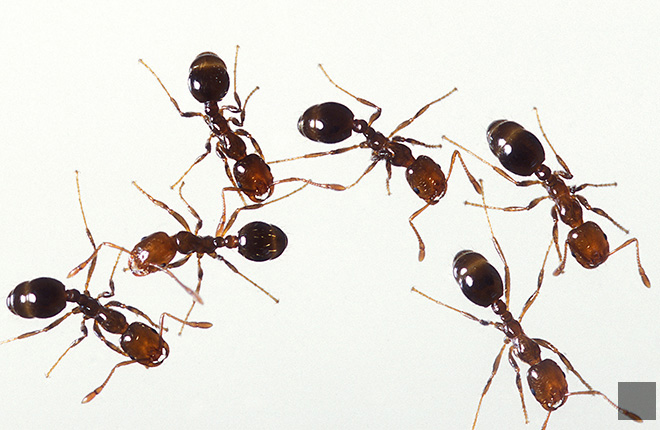Genetic Detective Work on Invasive Ants
In the United States, invasive ants cost billions of dollars annually in control, damage repair, and medical care. They infest millions of acres in urban, agricultural, wildlife, recreational, and industrial areas.
Knowing the history of an invasive organism like the tropical fire ant is a crucial step in finding the best natural enemies to fight it. Understanding how these fire ants moved around in the past also helps in developing methods to prevent them and other invasive ant species from invading other places.
An insightful genetic investigation by collaborative researchers at the Agricultural Research Service's Center for Medical, Agricultural, and Veterinary Entomology (CMAVE) in Gainesville, Florida; the University of Vermont; and the University of Illinois has revealed the invasion history of the tropical fire ant (Solenopsis geminata), an ant species known to be one of the earliest travelers around the globe by sea.
"We retraced the history of the tropical fire ant using genetic markers. By looking at patterns of genetic variation, we can infer the history of ant movement across the globe," says CMAVE entomologist DeWayne Shoemaker, whose earlier research reconstructed the invasion history of the red imported fire ant.
Shoemaker, former University of Illinois postdoctoral researcher Dietrich Gotzek, and former University of Vermont graduate student Heather Axen analyzed patterns of genetic diversity in the genomes of tropical fire ants from more than 190 locales. They also examined the trading patterns of Spanish vessels sailing back and forth in the 16th century from the New World.
"We theorized that tropical fire ants were likely moved around by people and that the early trade routes most likely provided that transportation," Shoemaker says. "Sure enough, when we started looking at the Spanish galley trade routes, the movement of the ants, inferred from genetics, mirrored the historic trade route."
The research showed that the tropical fire ant, a native of Central America and parts of South America, was transported by Spanish ships from Acapulco, Mexico, across the Pacific Ocean to the Philippines, and from there to other parts of the world. Today, it is found in nearly all tropical regions—including in Africa, the Americas, Australia, India, and Southeast Asia.
When ships travelled hundreds of years ago, many of them contained soil, used for ballast to stabilize the ship, Shoemaker says. The soil, which was dumped at different ports to make room for cargo, contained all kinds of organisms and likely included ant colonies.
"These findings add to the growing evidence that commerce is a good indicator of what we call 'propagule pressure'—the number of individual organisms being introduced in a new area," Shoemaker says. "For example, there are many more ships coming from Asia than from Australia. This means we're more likely to get exotic invaders from Asia than Australia, just by the fact of the volume of things coming in."—By Sandra Avant, Agricultural Research Service Information Staff.
"Genetic Detective Work on Invasive Ants" was published in the December 2015 issue of AgResearch Magazine.
Key Facts
- Invasive ants cost the United States billions of dollars annually.
- Genetic marker study reveals tropical ant history.
- The global movement of ants mirrors historic trade routes.
Full Story







